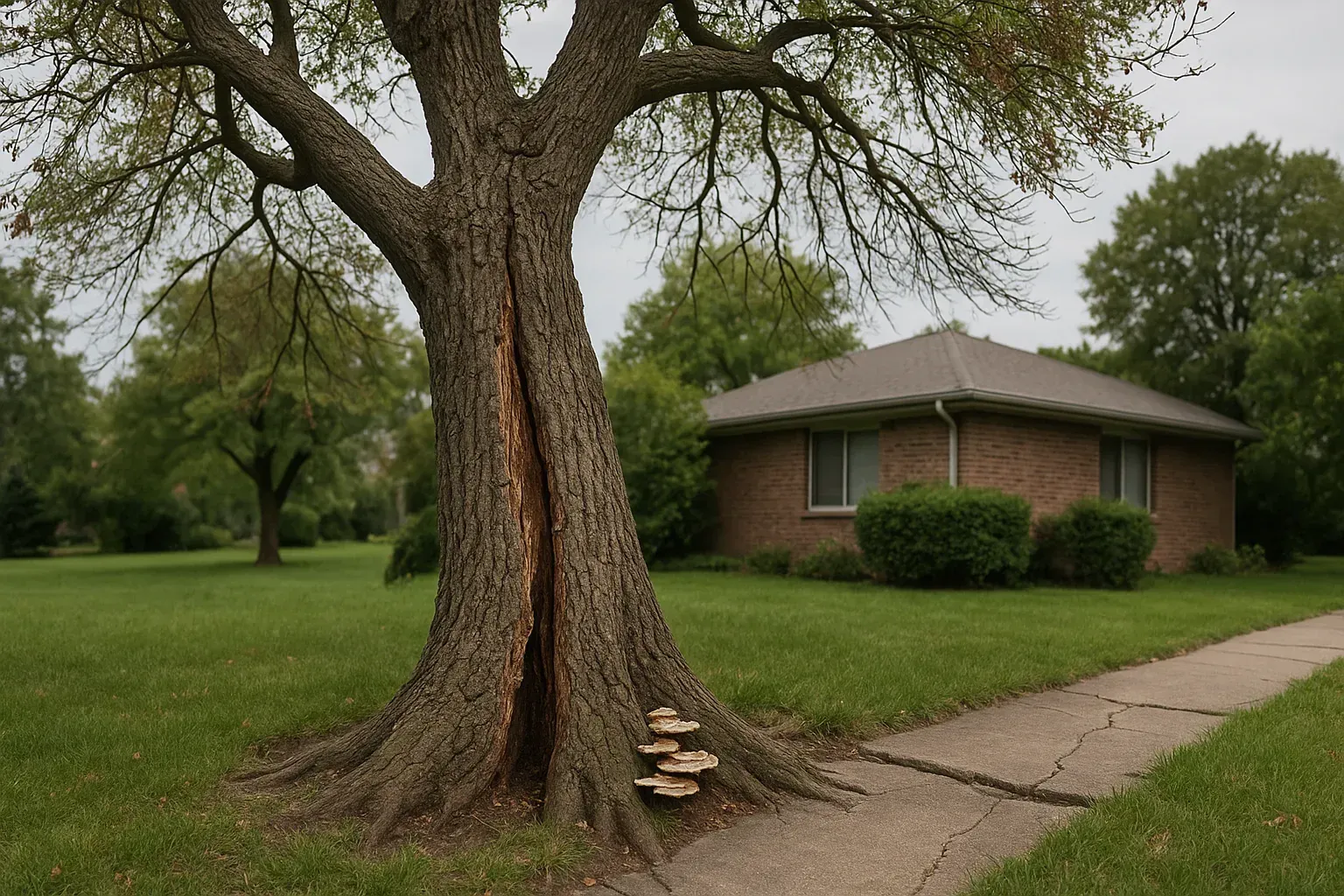Getting rid of a tree on your property isn’t always as simple as calling in a chainsaw. In many parts of Australia (especially in cities like Melbourne, Sydney, or Brisbane), local council rules around tree removal can be surprisingly strict.
One of the most common questions we get asked is: Do I need council approval to remove this tree?
In most cases, the answer is yes. Whether you're renovating, building a new home, or just trying to deal with a tree that’s gotten a bit too close for comfort, there's a good chance your local council will want a say.
Here’s how to tell if you need approval, and how to avoid fines, delays, or surprise headaches along the way.
Short on time? Try Our 90-Second Permit Check
- Measure & note
Trunk width at chest height, approximate height, and distance to buildings/pool/fences. - Open your council’s planning map
Search “(your council) planning map” and check for overlays: VPO/ESO/Heritage/BMO (names vary).
If an overlay applies, assume approval is needed. - Check species
If protected/significant in your LGA, assume approval is needed. - Assess condition
If clearly dead, failing or dangerous, you may be exempt - document it (photos + arborist note). - Still unsure?
Stop work and get advice/an arborist report. Cheaper than fines or delays.
Rule of thumb: if overlays or protection lists show up, get an arborist report before touching the tree.
Why Most Tree Removals Require a Permit
It might be your land, but that doesn’t always mean you can remove a tree without permission.
Most local councils have strict vegetation controls in place to protect urban canopy, biodiversity, and the overall character of the area. These rules apply just as much to private homeowners as they do to developers.
But permits aren’t just red tape. They’re part of a broader effort to:
- Preserve mature trees that provide habitat, shade, and erosion control
- Maintain consistent streetscapes and green corridors
- Prevent over-clearing in urban and semi-rural zones
What catches many people off guard is that these regulations are often tied to planning overlays, meaning you may need approval even for trees that seem unremarkable.
Ignoring the permit process can lead to
hefty fines, legal disputes, or even
delays to your renovation or development plans, making a
professional arborist report essential to save time, money, and stress down the line.
When You Might Not Need a Permit
There are scenarios where councils typically allow tree removal without a permit, provided documentation is in order:
- The tree is confirmed to be
dead or dying
- It poses a
direct safety risk to buildings, people, or infrastructure
- It’s located within
3 metres of an existing dwelling or pool (varies by council)
- It belongs to a
declared weed species or invasive plant list
Spotting the warning signs of tree decline early can help you get ahead of the permit process or request emergency removal if needed.
That said, many councils still require evidence from a qualified arborist before granting an exemption.
What Councils Will Approve (and Reject)
| ✅ Council-Approved Reasons for Tree Removal | ❌ Commonly Rejected Reasons |
|---|---|
| Tree is structurally unsound, decaying, or poses limb failure risk | Removal to improve views or aesthetics |
| Tree obstructs approved construction or is causing property damage | Tree sheds leaves, fruit, or bark |
| Tree interferes with underground services, retaining walls, or hardscaping | Tree is listed as significant or protected (e.g. on a heritage overlay) |
| Tree poses a high fire risk in a bushfire-prone zone | Tree is located in a conservation area or subject to a vegetation overlay |
The ‘Overlay Factor’ Most People Miss
Here’s where things often get tricky: even if a tree seems harmless, it could be protected just because of where it’s growing.
Our team frequently consults on sites affected by:
- Vegetation Protection Overlays
(VPOs): Common in suburban areas with established canopy coverage
- Environmental Significance Overlays
(ESOs): Often applied near watercourses, reserves, or ecologically sensitive areas
- Heritage Overlays: Protect historically important landscapes, even when trees are located on private land
- Bushfire Management Overlays
(BMOs): Require a nuanced balance between fire risk mitigation and vegetation retention
If your site falls under one of these, your council is going to need solid, site-specific evidence, and that’s where our
tailored arborist reports come in.
What Happens If You Remove a Tree Without Approval?
Short answer: don’t.
Removing a tree without approval can result in:
- Fines of up to $110,000
- Retrospective action from the council, including replanting orders
- Delays to your development approval or subdivision certification
- Legal challenges or permit withdrawal
We’ve helped plenty of clients clean up the mess after an unauthorised removal. It’s expensive, time-consuming and far easier to get it right from the start.
Is Pruning Considered Tree Removal?
You might think “a little trim won’t hurt”, but that’s not always how councils see it.
In many areas, pruning falls under regulation if it affects the tree’s health, structure, or growth. It’s not about what you’re doing, it’s about how much you’re taking off.
Here’s a quick guide:
| Permit Status | Permit Status Examples of Pruning<br> Activities |
|---|---|
| Usually not required | - Deadwood removal - Trimming for powerline clearance - Minor visibility improvements |
| Often regulated | - Removing more than 10% of live canopy within a 12-month period - Structural pruning (e.g. altering growth direction or removing large limbs) - Root pruning near foundations or within TPZ/SRZ zones |
In other words, pruning that alters the tree’s natural form, compromises its ability to thrive, or increases the risk of failure is often treated similarly to removal under planning law.
What Councils Look For
When assessing whether pruning requires approval, councils typically consider:
- The purpose of the pruning (safety, clearance, solar access, view enhancement, etc.)
- The species and retention value of the tree
- Whether the pruning is part of a
development application
- The
location of the cuts and their potential to create long-term defects
- The
cumulative impact if pruning has occurred in previous years
If pruning is likely to change the tree’s growth habit, reduce canopy coverage significantly, or trigger decline, it’s best to treat it as a regulated activity.
Example: Getting Approval Right
Imagine you’re planning a townhouse build, and there’s an old gum tree just 2.5 metres from the slab. It looks sickly (sparse canopy, signs of dieback), so removal seems like an easy call.
But here’s what can catch people out:
- The site sits in a Vegetation Protection Overlay (VPO)
- The tree species is locally protected
- No root zone assessment has been done
Without proper documentation, removal could trigger delays or fines.
In this case, we’d recommend a non-invasive root investigation and a detailed arborist report. With clear evidence of structural risk and root conflict, council approval is far more likely.
Result? Tree removal gets approved, and your build stays on track.
What to Prepare Before You Apply (or Claim an Exemption)
- Photos: whole tree, base, canopy defects, proximity to structures
- Measurements: trunk width @ chest height, height estimate, distances to buildings/pool
- Map evidence: screenshots showing overlays
- Damage/risk evidence: cracked paving/pipes, cavities, decay, lean, root upheaval
Arborist report (AQF L5): TPZ/SRZ to AS 4970, risk analysis (QTRA/TRAQ), clear recommendations
What to Prepare Before You Apply (or Claim an Exemption)
Skip the guesswork. At TMC Reports, our AQF Level 5 consulting arborists will do a free 5-minute council check and tell you….
- If approval is likely
- What evidence you’ll need
- The fastest path forward
All we need from you are 3–5 clear photos, the trunk width at chest height, an approximate tree height, its distance to the house, and your address.
Ready to keep your project moving without costly setbacks?
See also:
FAQs
Do I need approval to remove a dead tree?
Often no, but most Australian councils still require evidence before exempting a dead or dying tree.
Take dated photos from multiple angles and obtain a short AQF Level 5 arborist letter confirming condition and risk. If overlays apply (VPO/ESO/Heritage/BMO), assume approval may still be required and check first.
Can I prune without a permit?
Minor pruning is usually fine (deadwood, light clearance). You’ll likely need council approval if you remove >10% live canopy within 12 months, undertake structural pruning, or root pruning inside the TPZ/SRZ.
If the work could change the tree’s form or long-term health, treat it like a regulated activity and get advice.
What evidence speeds up approval?
Provide concise, verifiable artefacts:
Clear photos (whole tree, base, defects, proximity)
- Measurements (trunk @ chest height, height, distances)
- Planning map screenshots showing overlays (VPO/ESO/Heritage/BMO)
- Damage/risk proof (paving, pipes, cavities, dieback)
- AQF L5 arborist report with AS 4970 TPZ/SRZ and QTRA/TRAQ risk analysis
What if I’ve already removed a tree without approval?
Stop work immediately. Document the site with photos, keep the stump/wood if possible, and contact council. You may face fines or replanting orders.
Engage an AQF Level 5 arborist to prepare a remediation-focused report (condition, risk, mitigation, replanting plan) to help resolve compliance and prevent further penalties.
Ready to work with TMC Reports?
Let's connect! We’re here to help.
Send us a message and we’ll be in touch.
Or give us a call today at 0401 442 604


